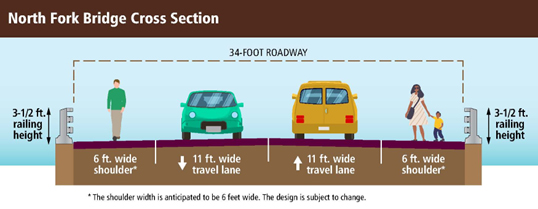North Fork Bridge Replacement Project

Above: A view of the current North Fork Bridge over the Snoqualmie River, looking south. The bridge is narrow, has weight limits, and is vulnerable to erosion.
Status update
This project is currently in early design. We plan to complete the design in mid-2028 and start building the new bridge in 2030.
Project overview
King County is replacing the North Fork Bridge on 428th Ave SE over the North Fork Snoqualmie River. We're also raising the road between SE Reinig Rd and just north of SE 92nd St.
This stretch of road often floods when the river rises. The current bridge, built in 1951, is too narrow, has weight restrictions, and sits low over the river. Heavy storms can damage the bridge and cut off access to the neighborhood.
Raising the road and building a taller bridge will help prevent flooding and keep the road open during severe weather.
Why we are replacing the bridge
We've decided to replace the bridge based on several factors:
- The 74-year-old bridge is too narrow, has weight limits, and aging components such as wooden guardrails that no longer meet modern safety standards.
- Over time, flooding, erosion, and river changes have weakened the bridge's supports. Replacing the bridge will help make travel safer and more reliable for the neighborhood.
- The bridge and road sit low above the river. During heavy storms, the road approaching the bridge from the north often floods, making travel dangerous and cutting off access to the nearby community.
- The piers under the bridge are too close together. This squeezes the river, making the water flow faster, which wears down the banks and makes it harder for fish to swim upriver.
- The bridge is not pedestrian-friendly. The current bridge has narrow shoulders and no sidewalks, making it unsafe for people to walk or bike across it.
Replacing the bridge has several benefits, including:
- Higher bridge deck – More water and woody debris, like fallen tree branches, can safely pass underneath, reducing flooding and the need for road closures during storms.
- Wider lanes – More room for larger vehicles, trucks, pedestrians, and cyclists to cross safely.
- Stronger structure – Built to better handle flooding and erosion.
- Better for the environment – Riverbanks will be restored, improving fish and wildlife habitat.
- Raising the roadway of 428th Ave SE – The road leading to the bridge often floods when the river rises, especially just north of SE 92nd St. We’re raising it by at least three feet to help keep it above floodwaters.

Above: A view of the current North Fork Bridge, looking south. The current bridge is narrow and weight-restricted.
Project timeline
The preliminary design will be finished by the end of 2025. We plan to complete the final design by mid-2028. Construction is expected to start in 2030 and will take about two years
Above: A timeline of design and construction.
Larger view (113KB)
What to expect during construction
Construction is expected to start in 2030 and take approximately two years to complete.
During construction, all traffic, including emergency vehicles, cyclists and pedestrians, will use a temporary bridge that will run parallel to the current bridge. Construction noise and lane restrictions are expected along 428th Ave SE and in the Ernie’s Grove community, but no detours should be necessary.
Public access to Three Forks Natural Area and Three Forks Park will be maintained. However, some areas of the park and river access points may temporarily close due to construction. Please see the graphic below for the temporary bridge layout and work areas.
Protecting the environment during construction
We will limit disruptions to fish, wildlife, and plants. Large rocks that protect bridge piers (shore armor) will be moved back to help riverbank habitats recover. To prevent soil from washing away, we use erosion and sediment control throughout construction.
Above: A map of the construction area and temporary bridge.
Larger view of map (1MB)
Future bridge layout
The future North Fork Bridge will feature two travel lanes, one northbound and one southbound, 6-foot-wide shoulders, and 3 ½ foot-high railings built to modern safety standards. The new bridge will be built in the same location as the old one. Please see the cross-section diagram below for a preliminary design.

Environmental improvements
Environmental improvements from the project include:
- Improved river flow – Moving the riverbanks back will give the river more space, slowing down the river’s flow, which reduces erosion of the riverbanks.
- Healthier habitat – Restoring the area around the bridge will create better conditions for fish and wildlife.
- More stable riverbanks – A wider river channel means the river is less likely to shift or erode nearby land.
Nearby projects
King County is working on another project in the area, the North Fork Snoqualmie River Confluence Revetment Removal Project. This project will remove an old rock wall from the riverbank near Three Forks County Park. The rock wall, or revetment, is no longer needed and removing it will allow the river to flow naturally, improve fish habitat, and reduce maintenance costs. This project is expected to be completed in 2025.

 Translate
Translate

